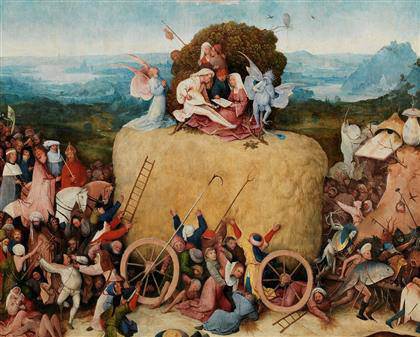
Jheronimus Bosch – The Haywain (detail)

Jheronimus Bosch – The Garden of Earthly Delights (detail)
Jheronimus Bosch exhibition at the Museo del Prado Museo del Prado marks the 5th centenary of the death of Jheronimus Bosch with the first monographic exhibition to be devoted to the artist in Spain, the most complete and the one of the highest quality organised to date. May 31 – September 11, 2016.]]>
Source: Museo del Prado / Fundación BBVA
With an installation as striking and exceptional as the exhibition itself, “Bosch. The 5th Centenary Exhibition” brings together more than 50 works, including 21 original paintings and 8 original drawings by Bosch, constituting more than 75% of his surviving output. It also includes prints, reliefs, miniatures and paintings by other artists, which explain the context in which Bosch created his oeuvre.
In addition to the Prado’s own holdings of the artist’s work, which are the largest and best in the world, including works such as the triptychs of “The Garden of Earthly Delights”, “The Haywain” and “The Adoration of the Magi”, the exhibition will feature loans such as “The Saint Anthony Triptych” from the Museo Nacional de Arte Antigua in Lisbon, “Christ carrying the Cross” from Patrimonio Nacional, “The Crowning with Thorns” from the National Gallery in London, and the drawing of the “Man-Tree” from the Albertina in Vienna, which is one of the artist’s great masterpieces.
“Bosch. The 5th Centenary Exhibition” focuses on the artist’s original works and is divided into seven sections. The first, “Bosch and ’s-Hertogenbosch”, locates visitors in the city where the artist lived throughout his life. Given the monographic character of this exhibition and due to the difficulty of establishing a chronology for Bosch’s works, his output has been divided into six thematic sections: The Childhood and Ministry of Christ; The Saints; From Paradise to Hell; The Garden of Earthly Delights; The World and Men: Mortal Sins and non-religious works; and The Passion of Christ.
The exhibition also includes works produced in Bosch’s studio or by followers from now lost originals. Another group, which includes paintings, miniatures, engravings by Alart du Hameel, reliefs by Adrien van Wesel and the manuscript of the “Comentario de la pintura” by Felipe de Guevara, allows for a better understanding of the context in which Bosch produced his works, the personality of some of his patrons, such as Engelbert II of Nassau, and the status of painting in the 16th century.
Related content
A painting from the Nelson-Atkins Museum has been attributed to Hieronymus Bosch (news, February 2016)
Follow us on:


